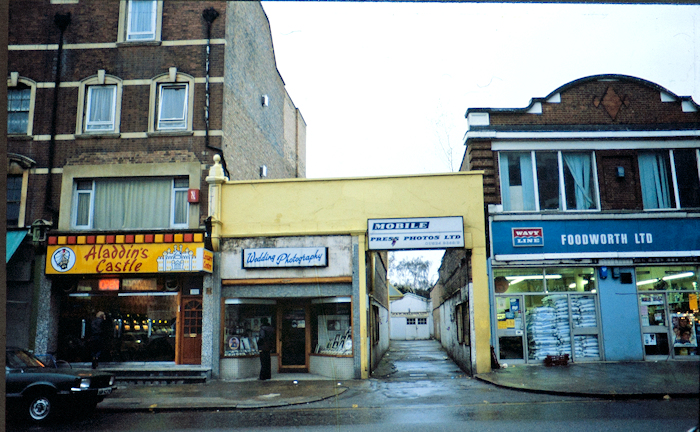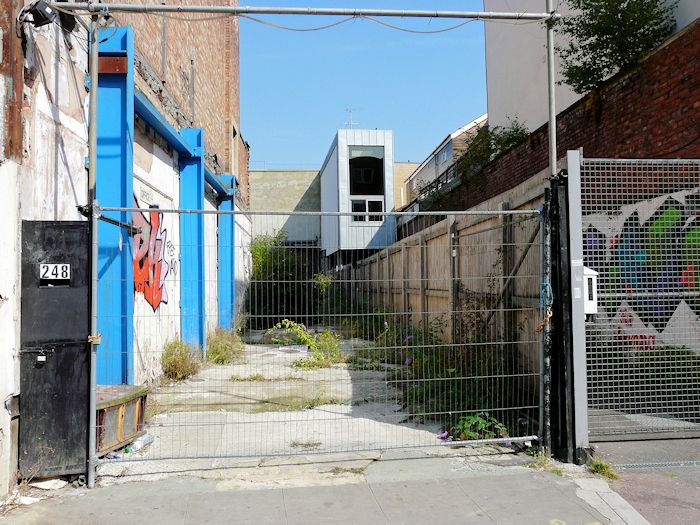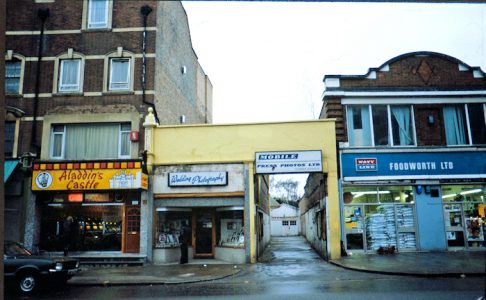Tracking down Kilburn’s misplaced cinema
Many buildings in Kilburn have interesting stories, but few can match 248 Kilburn High Road. The site, now demolished, has recently been given permission for two new-build blocks of flats. Residents will be living on top of a slice of media history.
In October 1908, American-born George Washington Grant and two partners formed the Biograph Theatre Company. They saw cinema as the growing medium and opened two Biograph cinemas in the Holloway Road and Peckham in 1909. The busy working-class area of Kilburn was a good place for their next venture. The partners approached Madame Goubert of 65a Brondesbury Villas (who owned several plant nurseries in Kilburn), and suggested opening a cinema and adjoining skating rink on her nursery ground behind Brondesbury Villas and the High Road. An application was made in her name on 19 November 1909, but it was refused by Willesden Council. Biograph persevered and in May 1910, The Biograph Theatre with 600 seats opened on the other side of the Kilburn High Road at No.236. The trade newspaper, Era, said, ‘It is doing remarkably well and is prettily decorated in brown and gold and is very cosy.’
By then the group had a chain of nine small cinemas in London. Unusually, the manager of the Kilburn branch was a woman, Mrs McCullah. However, the cinema had a short life and closed in 1917, unable to compete with the nearby Oswald Stoll-owned Grange Cinema. This had opened at the end of July 1914 with more than 2,000 seats, making it the largest purpose-built cinema in England. It was superseded in December 1937 when the iconic Gaumont State opened across the High Road with more than 4,000 seats. Biograph found it difficult to keep its chain profitable, and in 1922 the partners voted to voluntarily wind up the company.
Initial researchers of early cinema believed that the Biograph was situated behind today’s Speedy Noodle restaurant at 236 Kilburn High Road, on the corner of Grangeway. However, Grangeway was built after 1914. After the Biograph closed, 236 is not shown in the street directories until 1921 when Gerrard Costumiers opened there. The costumiers appeared again the following year, but in 1923 it appeared to have moved to 248 Kilburn High Road. In fact, it hadn’t moved at all – but this section of the High Road had been renumbered. The correct position of the original Biograph cinema is opposite Buckley Road, (near today’s Tricycle Cinema). Access was from the present day 248, with the cinema building reaching back behind the narrow shop front, almost as far as Grange Park. Several buildings lay behind the shop fronts.
From 1926, the cinema building was for many years a billiard hall run by W. Jelks and Sons. They made billiard tables in their Holloway Road factory and ran halls around London. The numbering of the building changed several times and was shown at various times as 246, 246a and 248.
Sadly, no photos of the old cinema seem to exist and all we have of this section of the High Road is one taken in 1979. This shows Mobile Press Photos who were at No.248 from about 1951 to the early 1980s. The long wall of the building behind the shop originally housed the old cinema.

Mobile Press Photos at 248 Kilburn High Road by Jean Smith, 1979
In 1931, Joseph Littman, who became a millionaire property speculator, bought the shop at 248 for his wife Evelyn as a gown and costumiers. Joseph had been born into a poor peasant family in Poland in 1898, had no schooling and had difficulty reading and writing. But he had a very good memory for figures and knew how to deal with people. The family first migrated to New York and Joe Littman came to London in the early 1920s. He married Evelyn Gold in 1925 in Paddington and was naturalised as a British citizen in 1935. Over the years he acquired large numbers of properties on the High Road and elsewhere in Kilburn. Then he bought properties in Oxford Street and the West End. Modestly, Littman said, ‘I have done pretty well for myself in ten years, but I would have still been keeping shop if I had not been willing to take the risk.’
He pioneered a funding technique of sale and leaseback that is widely used today, known as the ‘Littman Cocktail’. He sold the property to a large financial institution such as a building society, leased it back on a long-term lease of 99 or 999 years, and then sublet it to the occupier on a short lease. That way he made money as the property increased in value over time.
Joe was a modest man who lived a simple life dedicated to his family and friends. Towards the end of his life he suffered from poor health and died of lung cancer in one of his hotels, the Palace Court Bournemouth, on 20 August 1953, aged 55. He left £3.2 million, worth about £82 million today.
Fast-forwarding 50 years, in January 1986, Steve Flood and Stuart Colman opened Master Rock Studios at 248 in the old cinema building. Stuart Colman was a musician who produced hits for Shakin’ Stevens, The Shadows, Kim Wilde, and Alvin Stardust. He also worked as a presenter at the BBC before opening Master Rock Studios. Flood and Colman were soon joined by studio manager Robyn Sansone who came from New York. An amazing number of musicians recorded, or had their albums mastered here including Elton John, Jeff Beck, U2, Eric Clapton, Roxy Music, Simply Red, Oasis, Robbie Williams and Suede.
Flood and Coleman wanted the very best quality mixing and recording equipment so they bought a Focusrite console. Focusrite was founded in 1985 with the aim of producing the highest-quality recording console available at the time, regardless of cost. The prohibitively expensive design, however, limited production to just two units. One console was delivered to Master Rock Studios in Kilburn and the other to the Electric Lady Studio that Jimi Hendrix had built in New York.
Bernard Butler, the guitarist with Suede, who recorded at Master Rock said, “Master Rock Studios was originally haunted by buying one of the only custom-made Focusrite consoles. It arrived several months late so left them without business for a long time and despite being used on everything after it arrived, I don’t think they recovered.”
Despite being busy, the studio had financial problems and in 1991 the business was put up for sale, eventually closing in March 2000.

248 High Road by Dick Weindling, September 2013


Comments
Tracking down Kilburn’s misplaced cinema — No Comments
HTML tags allowed in your comment: <a href="" title=""> <abbr title=""> <acronym title=""> <b> <blockquote cite=""> <cite> <code> <del datetime=""> <em> <i> <q cite=""> <s> <strike> <strong>